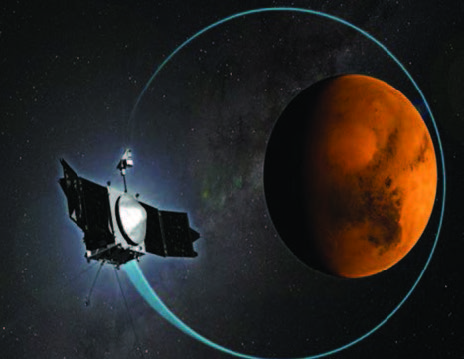
The first planet detected by the Gemini Planet Imager (GPI) from an international team of astronomers, which includes two scientists from the Department of Physics & Astronomy at Stony Brook University, is one outside earth’s solar system at 100 light years away. The exoplanet is being called a “young Jupiter” by the researchers because it shares many characteristics of Jupiter. A paper outlining the full findings is published in Science.
The finding could serve as a decoder ring for astronomers to understand how planets formed around our sun because one of the best ways to learn how our solar system evolved is to look to younger star systems in the earlier phase of development.
Stanimir Metchev, a Physics & Astronomy Professor at Western University in Canada and at Stony Brook University, is a co-investigator on the scientific study, along with Rahul I. Patel, a PhD student in Stony Brook’s Department of Physics & Astronomy. They are both members of the international Gemini Planet Imager Exoplanet Survey (GPIES) team, which is dedicated to imaging and characterising exoplanets, planets discovered outside of earth’s solar system.
The new planet is called 51 Eridani B The GPI is a new astronomy instrument operated by an international collaboration headed by Bruce Macintosh, a Professor of Physics in the Kavli Institute at Stanford. The exoplanet is the ‘faintest’ one on record, and also shows the strongest methane signature ever detected on an alien planet, which should yield additional clues as to how the planet formed.
The key to the solar system?
“What makes 51 Eridani particularly interesting is that it also harbours dust and ice in the planetary system,” explains Professor Metchev. “These are much like the dust and the ice grains produced by collisions among asteroids and comets in the Solar System.”
Metchev’s team conducted a study with data from NASA‘s Wide-field Infrared Survey Explorer (WISE) to search for any thermal glow that such dust and ice can produce.
“We found that 51 Eridani is surrounded by warm dust that indicates the presence of an asteroid belt,” says Patel, who led the WISE study and whose previous work identifying recycled planetary dust, known as “debris disks,” around close to a hundred other star systems, puts the discovery of the exoplanet in context.“Finding dust around a star is like seeing a large signpost that tells us there might be a planet,” he adds.
“This is because the dust is usually created when lots of large asteroids collide and destroy each other, usually pushed around by a large planet – like 51 Eridani b.”
Metchev adds, “And more data from the European Space Agency’s Herschel Space Observatory reveal that 51 Eridani is also surrounded by a more distant and colder cometary belt, much like the Kuiper Belt of comets beyond Neptune in the Solar System.”
The two belts – the asteroid and the cometary belt around 51 Eridani – fall on either side of the newly discovered planet 51 Eridani b. “The overall structure bears striking resemblance to our own Solar System, with Jupiter as the most massive planet orbiting between a belt of asteroids and a belt of comets,” explains Metchev. “In 51 Eridani, we are therefore seeing what the Solar System resembled at a very young age, around the time when the Earth was still forming.”
A clear line of sight
The GPI was designed specifically for discovering and analyzing faint, young planets orbiting bright stars. NASA’s Kepler mission indirectly discovers planets by the loss of starlight when a planet blocks a star.
“To detect planets, Kepler sees their shadow; GPI sees their glow,” says Macintosh. “What GPI does is referred to as direct imaging.”
The astronomers use adaptive optics to sharpen the image of a star, and then block out the starlight. Any remaining incoming light is then analyzed, the brightest spots indicating a possible planet.
After GPI was installed on the 8-meter Gemini South Telescope in Chile, the team set out to look for planets orbiting young stars. To date, the astronomers have looked at nearly 100 stars. “51 Eridani is only 20 million years old, a little more massive than our sun – a perfect target,” says James Graham, a professor at UC Berkeley and Project Scientist for GPI.
As far as the cosmic clock is concerned, 20 million years is young for a star, and this is exactly what made the direct detection of the planet possible, explains Macintosh.
“When planets coalesce, material falling into the planet releases energy and heats it up. Over the next hundred millions years they radiate that energy away, mostly as infrared light,” says Macintosh.





Be the first to comment